 Dr Srikanta K. Panigrahi
Dr Srikanta K. Panigrahi
Director General and Distinguished Research Fellow, IISD
Indian Policy Maker and Technocrat
When trees are burned or catch fire, their stored carbon is released into the air as carbon dioxide (CO2) and this is how Forest Fires contribute to global warming. The Deforestation or the Loss of trees and other vegetation, caused by the forest fire; can result in climate change, desertification, soil erosion, fewer crops, flooding, increased greenhouse gases in the atmosphere, and a host of other problems also for the local indigenous people.
Global heating is contributing to forest fires, and those fires are stoking further heating: a deadly cycle. Observations over the past twenty years show that the increasing intensity and spread of forest fires in Asia were largely related to rises in temperature and declines in precipitation, in combination with an increasing intensity of land use (IPCC 2007).
Various anthropogenic factors combine to cause uncontrolled fires. Fires of varying intensity and extent can affect thousands of hectares of forest every year, seriously influencing factor on nutrient cycling and functioning of ecosystem. Some forest ecosystems have evolved in response to frequent fires from natural causes, but most are susceptible to the damaging effects of wildfire. Each year millions of hectares of the world’s forests are lost by fire, resulting in economic losses, environmental damage, and the loss of human life as well as wild flora and fauna. In recent days, Amazon Forest Fire, Australian Bushfires of 2019, Californian Forest Fires as well as many forest fire incidents in Madhya Pradesh and Uttarakhand States Of India, have caused serious concerns.
The Scientists have recorded highest, i.e more than 74,000 forest fires in Brazil in 2019. That’s nearly double 2018’s total of about 40,000 fires. The Forest Survey of India released a report last year, analyzing areas in India prone to fires. Out of the total 7,12,249 square km of forest cover, 1,52,421 square km (21.40 percent) is either highly or extremely fire prone. The forests of Mizoram, Chhattisgarh, Manipur, Odisha and Madhya Pradesh are most vulnerable.
The forests of Uttarakhand have not stopped burning in the last six months. Fires have continued to erupt one after another. The season between winter and monsoon, referred to as the ‘forest fire season’, is now increasing. Climate change and consequently scarce rainfall in the Himalayan regions plays a huge role. Uttarkhand ranked second in the country after Madhya Pradesh in terms of active instances of fire on April 5, 2021 according to the Forest Survey of India. There were 93 active instances of fire in Madhya Pradesh and 71 in Uttarakhand.
India recorded 82,170 forest fire alerts from April 1-14, 2021 nearly double the number reported during the same period past year, according to Global Forest Watch (GFW), an open-source monitoring application. The number of forest fire alerts in April 2021 is also the highest in five years, according to the data. The second-highest was during the corresponding period of 2017.
Amazon Rainforest Wildfires
The 2019 Amazon rainforest wildfires season saw a year-to-year surge in fires occurring in the Amazon rainforest and Amazon biome within Brazil, Bolivia, Paraguay, and Peru during that year’s Amazonian tropical dry season. Fires normally occur around the dry season as slash-and-burn methods are used to clear the forest to make way for agriculture, livestock, logging, and mining, leading to deforestation of the Amazon rainforest. Such activity is generally illegal within these nations, but enforcement of environmental protection can be lax. The increased rates of fire counts in 2019 led to international concern about the fate of the Amazon rainforest, which is the world’s largest terrestrial carbon dioxide sink and plays a significant role in mitigating global warming.
The increasing rates were first reported by Brazil’s National Institute for Space Research (Instituto Nacional de Pesquisas Espaciais, INPE) in June and July 2019 through satellite monitoring systems, but international attention was drawn to the situation by August 2019 when NASA corroborated INPE’s findings, and smoke from the fires, visible from satellite imagery, darkened the city of Sao Paulo despite being thousands of kilometers from the Amazon. As of August 29, 2019, INPE reported more than 80,000 fires across all of Brazil, a 77% year-to-year increase for the same tracking period, with more than 40,000 in the Brazil’s Legal Amazon (Amazonia Legal or BLA), which contains 60% of the Amazon. Similar year-to-year increases in fires were subsequently reported in Bolivia, Paraguay and Peru, with the 2019 fire counts within each nation of over 19,000, 11,000 and 6,700, respectively, as of August 29, 2019. It is estimated that over 906 thousand hectares (2.24×106 acres; 9,060 km2; 3,500 sq mi) of forest within the Amazon biome has been lost to fires in 2019.[4] In addition to the impact on global climate, the fires created environmental concerns from the excess carbon dioxide (CO2) and carbon monoxide (CO) within the fires’ emissions, potential impacts on the biodiversity of the Amazon, and threats to indigenous tribes that live within the forest. Ecologists estimated that the dieback from the Amazon rainforest due to the fires could cost Brazil US$957 billion to US$3.5 trillion over a 30-year period.
The increased rate of fires in Brazil has raised the most concerns as international leaders, particularly French president Emmanuel Macron, and environmental non-government organizations (ENGOs) attributed these to Brazilian president Jair Bolsonaro’s pro-business policies that had weakened environmental protections and have encouraged deforestation of the Amazon after he took office in January 2019. Bolsonaro initially remained ambivalent and rejected international calls to take action, asserting that the criticism was sensationalist. Following increased pressure at the 45th G7 summit and a threat to reject the pending European Union-Mercosur free trade agreement, Bolsonaro dispatched over 44,000 Brazilian troops and allocated funds to fight the fires, and later signed a decree to prevent such fires for a sixty-day period.
Other Amazonian countries have been affected by the wildfires in higher or lesser degree. The number of hectares of Bolivian rainforest affected by the wildfires were roughly equal to those of Brazil, being the area of Bolivia only about one-eighth of Brazil’s. Bolivian president Evo Morales was similarly blamed for past policies that encouraged deforestation, Morales has also taken proactive measures to fight the fires and seek aid from other countries. At the G7 summit, Macron negotiated with the other nations to allocate US$22 million for emergency aid to the Amazonian countries affected by the fires.
Australian Bushfire had widespread impacts
The 2019-20 Australian bushfire season, colloquially known as the Black Summer, was a period of unusually intense bushfires in many parts of Australia.
In June 2019, the Queensland Fire and Emergency Service acting director warned of the potential for an early start to the bushfire season which normally starts in August. The warning was based on the Northern Australia bushfire seasonal outlook noting exceptional dry conditions and a lack of soil moisture, combined with early fires in central Queensland. Throughout the summer, hundreds of fires burnt, mainly in the southeast of the country. The major fires peaked during December-January.
As of 9 March 2020, the fires burnt an estimated 18.6 million hectares (46 million acres; 186,000 square kilometres; 72,000 square miles), destroyed over 5,900 buildings (including 2,779 homes) and killed at least 34 people. Nearly three billion terrestrial vertebrates alone – the vast majority being reptiles – were affected and some endangered species were believed to be driven to extinction. At its peak, air quality dropped to hazardous levels in all southern and eastern states. The cost of dealing with the bushfires is expected to exceed the A$4.4 billion of the 2009 Black Saturday fires, and tourism sector revenues fell by more than A$1 billion. However, economists estimated that the Australian bushfires may cost over A$103 billion in property damage and economic losses, making the bushfires Australia’s costliest natural disaster to date. Nearly 80 percent of Australians were affected either directly or indirectly by the bushfires. By 7 January 2020, the smoke had moved approximately 11,000 kilometres (6,800 mi) across the South Pacific Ocean to Chile and Argentina. As of 2 January 2020, NASA estimated that 306 million tonnes (337 million short tons) of CO2 had been emitted.
From September 2019 to March 2020, fires heavily impacted various regions of the state of New South Wales. In eastern and north-eastern Victoria large areas of forest burnt out of control for four weeks before the fires emerged from the forests in late December. Multiple states of emergency were declared across New South Wales, Victoria, and the Australian Capital Territory. Reinforcements from all over Australia were called in to assist fighting the fires and relieve exhausted local crews in New South Wales. The Australian Defence Force was mobilised to provide air support to the firefighting effort and to provide manpower and logistical support. Firefighters, supplies and equipment from Canada, New Zealand, Singapore and the United States, among others, helped fight the fires, especially in New South Wales.
During the ensuing crisis, an air tanker and two helicopters crashed during firefighting operations, the air tanker crash resulting in the deaths of the three crew. Two fire trucks were caught in fatal incidents caused directly by fire conditions, killing three fire fighters.
By 4 March 2020, all fires in New South Wales had been extinguished completely (to the point where there were no fires in the state for the first time since July 2019), and the Victoria fires had all been contained. The last fire of the season occurred in Lake Clifton, Western Australia, in early May.
There has been considerable debate regarding the underlying cause of the intensity and scale of the fires, including the role of fire management practices and climate change, which during the peak of the crisis attracted significant international attention, despite previous Australian fires burning much larger areas (1974-75) or killing more people (2008-09). Politicians visiting fire impacted areas received mixed responses, in particular Prime Minister Scott Morrison. An estimated A$500 million was donated by the public at large, international organisations, public figures and celebrities for victim relief and wildlife recovery. Convoys of donated food, clothing and livestock feed were sent to affected areas.
Australia’s devastating 2019-20 fire season-so dramatic it could be seen from space-produced more than twice as much carbon dioxide (CO2) as previously estimated, Science News reports. Earlier estimates put the amount of CO2 released by the fires at 275 million tons, based on the size of the area and the amount of plant material burned. The amount of CO2 emitted into the atmosphere was actually closer to 715 million tons, the team reports this week in Nature. Another team, also reporting this week in Nature, found that smoke from the fire traveled thousands of kilometers over the Southern Ocean and infused the water with iron-a key nutrient for algae. The resulting algal blooms, which were bigger than Australia, illustrate how much more there still is to learn about the impacts of wildfires, researchers say.
Intense Blazes, the Bootleg Fire in Oregon, USA
Researchers fear intense blazes, such as the Bootleg Fire in Oregon this year, has killed old-growth trees and damage soil, making it more difficult for forests to regenerate. The air was tinged with the scent of fire in the Blue Mountains area – smoke from the Bootleg Fire burning 230 kilometers to the southwest. That blaze would eventually grow to more than 160,000 hectares. It was just one of more than 80 large wildfires that have broken out this summer in the United States and Canada, destroying communities and enveloping the continent in a persistent brown haze.
The warming climate increases the risks of wildfires so intense that they sterilize soils and kill massive old trees. Helping forests become more resilient is critical, Under such a situation; growing trees under hotter, drier conditions, becomes more difficult.
Spain Wildfire
More Evacuated as Spain Deploys Military Against Wildfire
Soldiers are being deployed in south-eastern Spain to join the battle against a major wildfire that is burning continuously. It has already destroyed, within first four days; more than 6,000 hectares (15,000 acres) of forest and prompted fresh evacuations, bringing the total number of residents displaced to around 2,000.
Authorities preventively removed residents from the town of Jubrique, population 500, and announced they would also evacuate the 400 inhabitants of Genalguacil. Over 1,000 more had already been evacuated before the weekend from other areas surrounding the resort town of Estepona, popular among tourists and foreign expats. A military unit has to travel from the military base of Morn, in southern Spain, to join more than 300 firefighters and 41 water-dropping aircraft battling the flames.
Infoca, the Andalusia regions agency, in charge of firefighting efforts, described their focus on four hot areas, for bringing the blaze under control. Infoca released aerial pictures showing towering plumes of smoke emerging from a rugged terrain that it said made the crews’ access on the ground difficult. A combination of hot and dry temperatures with strong winds created a perfect storm turning the blaze.
Wildfires are common in southern Europe during the hot, dry summer months, but have been particularly numerous around the Mediterranean this year, worsened by the intense August heatwaves. In Spain, over 75,000 hectares (186,000 acres) of forest and bush areas have burned in the first eight months of the year, according to official data from Spain’s Ministry of Ecological Transition.
The Author is a Leading Indian Sustainability Thought Leader and Director General at Indian Institute of Sustainable Development (IISD), New Delhi and deeply engaged in Climate Action Leadership Initiatives of UNFCCC, UNEP and Government of India.

Source : Hindustan Times on OCT 10, 2018 09:58 AM IST - More forest fires may burn as climate change triggers extreme weather patterns, warns govt
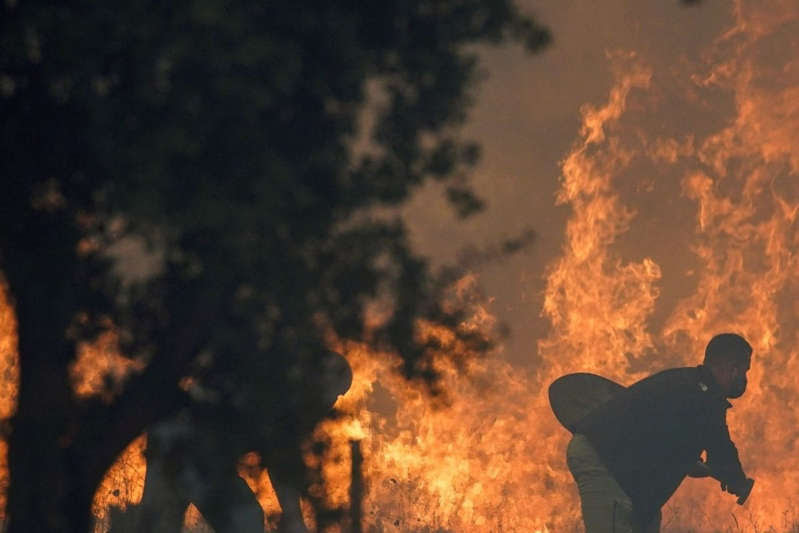
Provided by News18: More Evacuated as Spain Deploys Military Against Wildfire
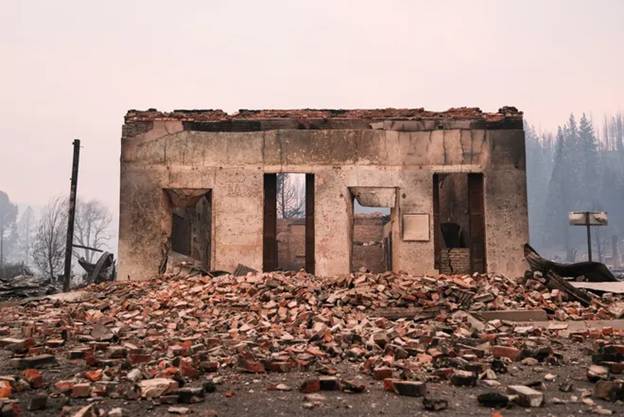
The view of the remains of a structure destroyed by the Dixie Fire, situated near Highway 89 on August 8, 2021 in Greenville, California.
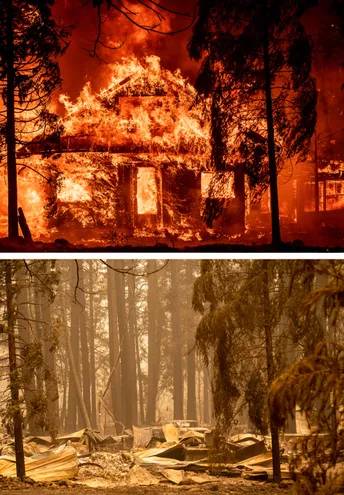
In this photo combination, a home is seen burning (above) on July 24, 2021 and the remains are seen two days later on July 26, 2021 during the Dixie fire in the Indian Falls neighborhood of unincorporated Plumas County, California. The monstrous Dixie Fire in northern California has grown to become the second-largest wildfire in state history, authorities, with three people reported missing and thousands fleeing the advancing flames.
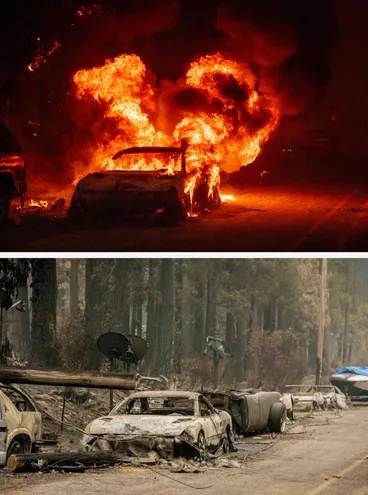
In this photo combination, a before and after series shows a vehicle exploding into flames (above) on July 24, 2021 and after it burned on August 7, 2021 during the Dixie fire in the Indian Falls neighborhood of unincorporated Plumas County.
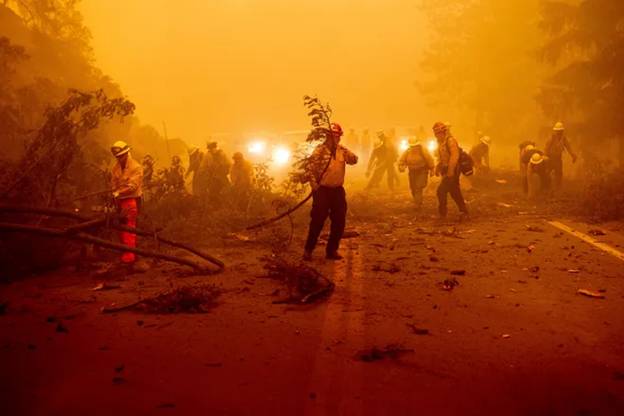
In this photo combination, a before and after series shows a vehicle exploding into flames (above) on July 24, 2021 and after it burned on August 7, 2021 during the Dixie fire in the Indian Falls neighborhood of unincorporated Plumas County.
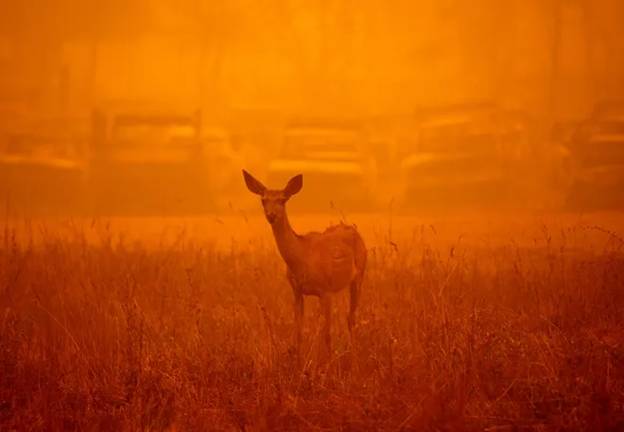
A deer wanders in heavy smoke in front of a row of burned cars during the Dixie fire in Greenville, California on August 6, 2021. A huge wildfire tearing through northern California became the third-largest in the state's history August 6, 2021, and looked set to continue growing. The Dixie Fire, which this week razed the Gold Rush town of Greenville, has torched more than 1,700 square kilometers (650 square miles) since it erupted in mid-July.
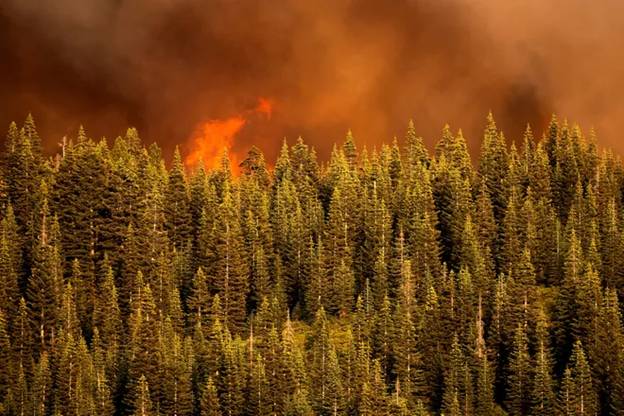
Flames from the Dixie Fire crest a ridge in Lassen National Forest, Calif., near Jonesville on Monday, July 26, 2021.
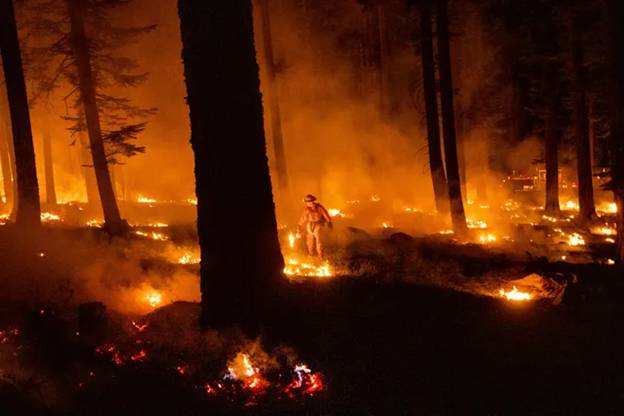
A firefighter uses a drip torch to ignite vegetation while trying to stop the Dixie Fire from spreading in Lassen National Forest, Calif., on Monday, July 26, 2021.
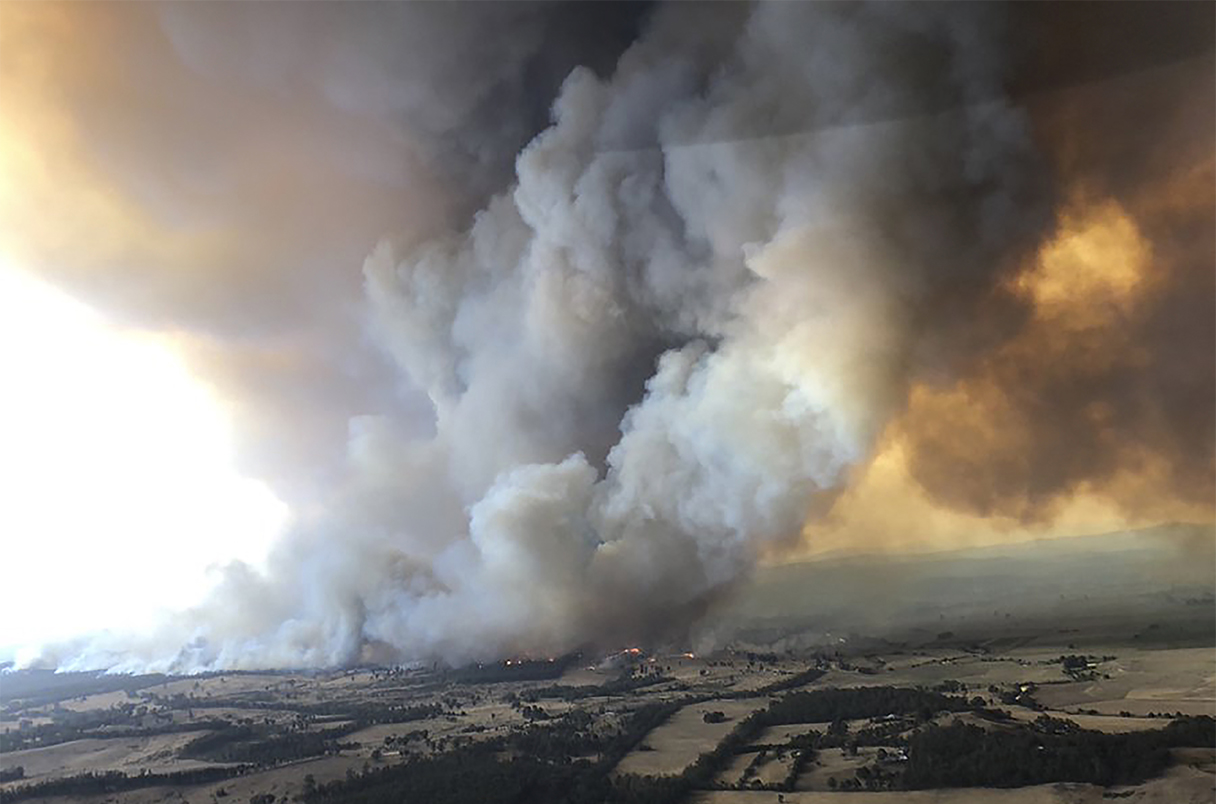
Australian bushfires had widespread impacts
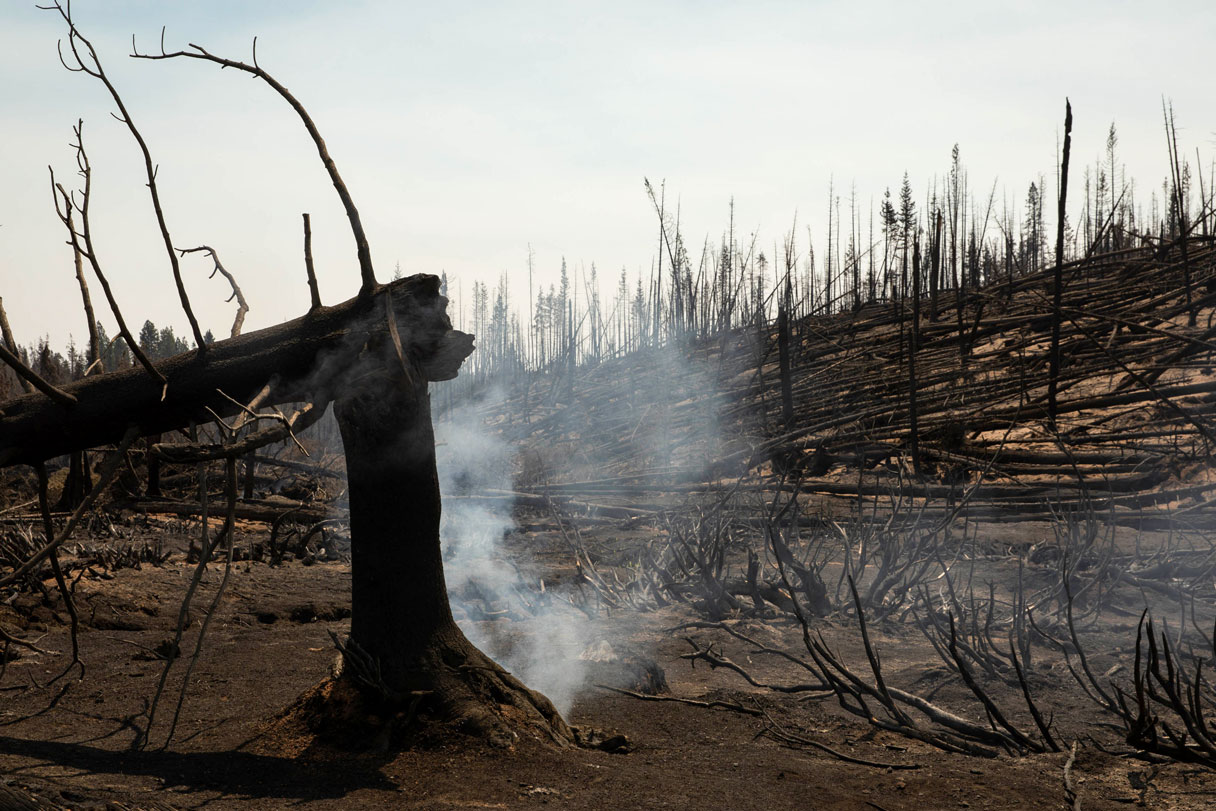
Intense Blaze such as the Bootleg Fire in Oregon USA
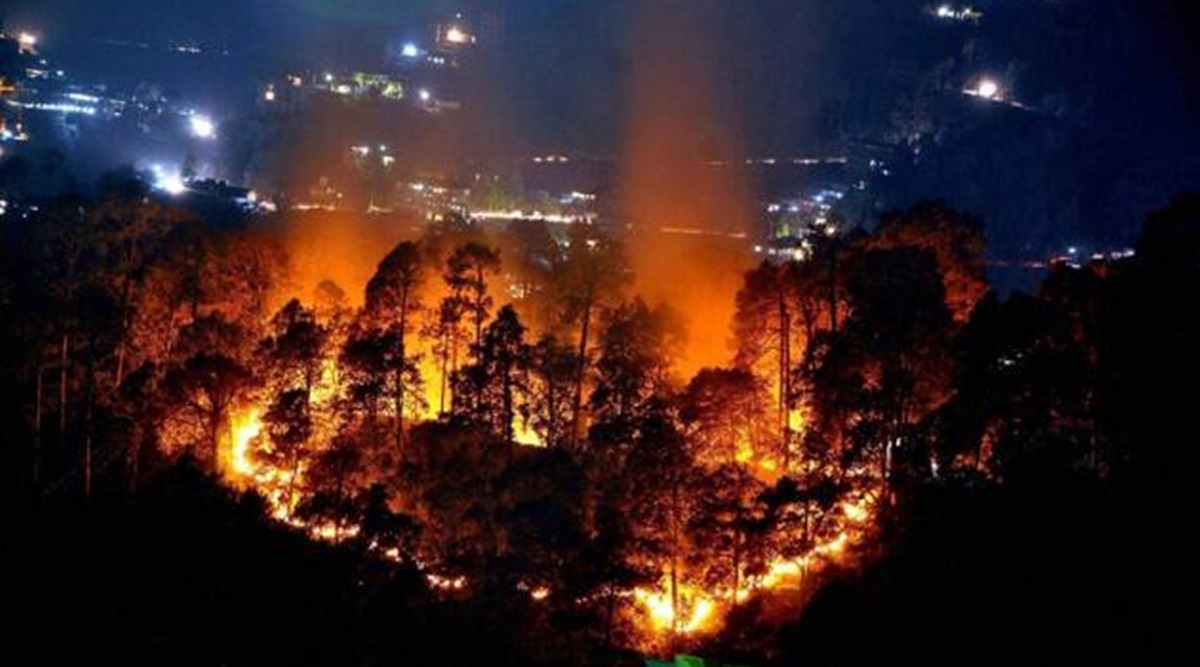
Uttarakhand Forest Fire

MP Forest Fire
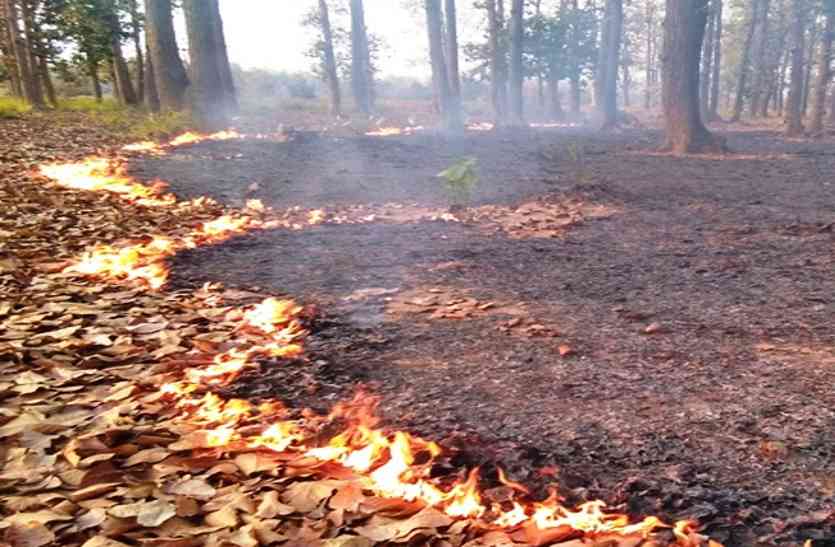
Chattisgarh Forest Fire






